For serious marathon training, a reliable heart rate watch is essential. The Garmin Forerunner 265 offers 20-hour battery life while Coros Vertix 2S delivers an impressive 118-hour GPS tracking. Look for dual-frequency GPS accuracy, heart rate zone monitoring, and recovery metrics like HRV. Train smarter by targeting specific zones (50-100% HRmax) to optimize endurance and prevent injury. The right watch transforms not just your race day, but your entire preparation journey.
Why Heart Rate Data Transforms Marathon Training
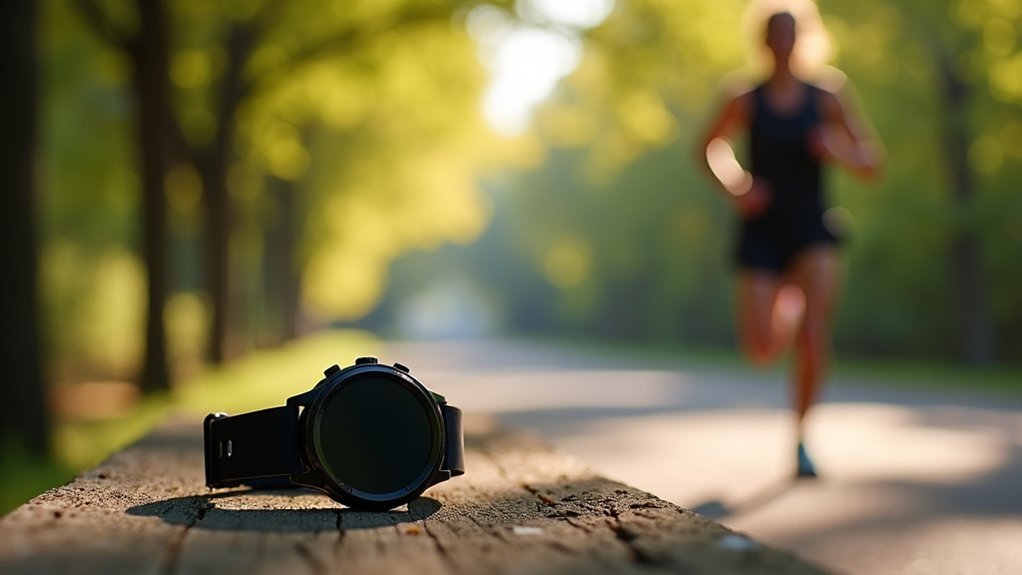
While many runners focus solely on distance and pace, heart rate data provides a revolutionary approach to marathon training.
You’ll discover the vital difference between perceived effort and actual physiological strain, allowing you to recognize fatigue before injury occurs.
Training in specific heart rate zones, particularly Zone 2, builds the endurance foundation essential for marathons. This low-intensity training increases mitochondrial efficiency, enhancing your body’s ability to burn fat as fuel—an unlimited energy source during long races. Heart rate monitors like Garmin watches allow for real-time monitoring of your current zone during runs.
Unlike one-size-fits-all training plans, heart rate monitoring creates a personalized approach based on your unique physiology.
Your maximum heart rate differs from other runners, meaning you need individualized zones to optimize performance. This tailored method improves race times while reducing overtraining risk, helping you maintain consistent performance throughout your racing season.
Decoding the Five Training Zones for Marathon Success
Because every step of your marathon journey demands strategic training, understanding heart rate zones is essential for peak performance.
These zones, categorized by percentage of maximum heart rate, offer a personalized approach to your training regimen.
Zone 1 (50-60% HRmax) serves as your recovery foundation, ideal for active rest days through walking or light cycling.
Zone 2 (60-70%) builds vital endurance through fat oxidation during longer, easier runs.
Zone 3 (70-80%) enhances your cardiovascular fitness through tempo runs, improving your lactate threshold.
Zone 4 (80-90%) develops speed and power through high-intensity intervals, boosting anaerobic capacity.
Zone 5 (90-100%) focuses on maximum effort sprinting to improve your running economy, form, and top-end speed.
Essential Features to Look for in a Runner’s Heart Rate Watch
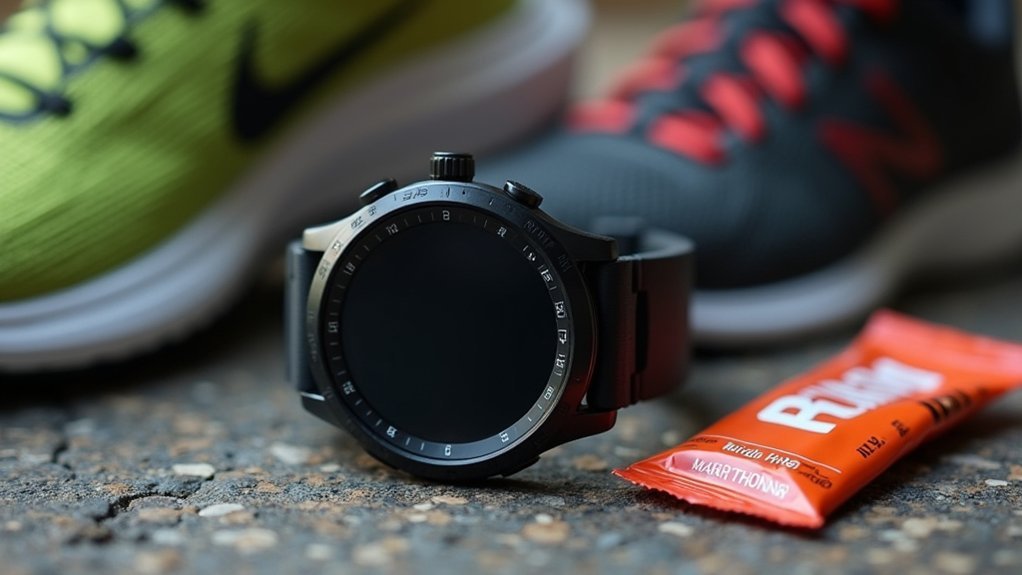
When shopping for a marathon-ready heart rate watch, you’ll want GPS accuracy within 5% of actual distance to effectively track your training routes and race performance.
Your ideal watch should deliver actionable heart metrics that sync with your training zones, helping you maintain proper intensity during various workouts. Advanced watches like the Polar Pacer Pro include features like Training Load Pro to help monitor your overall training stress and recovery needs.
Look for features that translate heart data into practical training insights, such as recovery recommendations and performance tracking that show how your cardiovascular system adapts to your marathon preparation.
GPS Accuracy Matters
Since your marathon success depends heavily on pacing, GPS accuracy stands as a non-negotiable feature in any runner’s heart rate watch.
Look for multiband or dual-band GPS technology, which processes multiple frequencies to deliver precise tracking in challenging environments like urban areas with tall buildings.
High-quality satellite signal reception reduces measurement errors during long runs, ensuring your training data remains reliable. The Garmin Forerunner 265 offers accurate multi-band GPS tracking along with additional running metrics displayed in watts. The best watches integrate accurate heart rate monitoring with GPS data, giving you extensive performance insights.
When selecting your watch, prioritize models with reliable route mapping capabilities and minimal distance error rates (under 3%).
Remember that your behavior—like weaving through crowds—can affect GPS accuracy. Brands like Garmin and Coros consistently rank highest for GPS precision, essential for serious marathon training.
Actionable Heart Metrics
While many watches claim to track heart data, serious marathon runners need features that transform raw numbers into meaningful guidance.
Look for watches that accurately track heart rate variability (HRV) and establish your resting heart rate baseline—these metrics reveal recovery status and training readiness.
Prioritize devices offering customizable heart rate zones based on your specific maximum heart rate, not just generic formulas. Modern heart rate watches maintain system stability throughout your entire marathon, ensuring reliable data collection even during long-distance events.
Real-time feedback during runs helps you maintain proper intensity, while post-run analytics identify trends in your cardiovascular performance.
The most valuable watches estimate lactate threshold and VO2 max, transforming your training approach with science-backed precision.
They’ll also alert you to abnormal heart patterns that might signal overtraining or health concerns.
Choose models that integrate with your training log software for thorough performance tracking.
Top Heart Rate Watches That Go the Distance
For elite marathon runners, the Garmin Fenix 8 stands out with its exceptional GPS accuracy and heart rate tracking that won’t quit during your longest training sessions.
You’ll appreciate the extended battery life of watches like the Forerunner 265, which offers 19-20 hours of GPS runtime—more than enough to cover marathon distances with power to spare.
If you’re training for ultra-distances, consider specialized endurance models that balance performance features with battery efficiency to keep you informed throughout your entire journey. The Fenix 8 delivers an impressive 10 days of battery with the always-on display feature activated, making it ideal for multi-day training blocks.
Endurance-Focused Elite Watches
When marathon runners push their limits across 26.2 miles, elite endurance watches become vital companions rather than mere accessories. These premium devices offer advanced training tools like Training Readiness Scores and Chronic Training Load metrics that help you optimize performance while preventing injury. Premium models like the Garmin Fenix 7 provide exceptional dual-frequency GPS accuracy that outperforms standard GPS watches.
- PacePro technology guides your pace strategy throughout the race, adapting to elevation changes.
- Real-time heart rate monitoring combined with HRV tracking provides insights into exertion and recovery.
- Lightweight titanium construction guarantees comfort during those final grueling miles.
- Customizable workouts let you tailor training specifically to marathon preparation.
- Advanced GPS accuracy tracks your exact route and distance, essential for race-day performance.
The best endurance watches blend durability with sophisticated analytics, giving you extensive data without sacrificing battery life during those long training runs.
Battery Life Champions
Every marathon runner’s nightmare unfolds when their watch dies at mile 20, taking critical pacing data with it. The new generation of watches eliminates this anxiety with impressive battery performance.
The Coros Vertix 2S leads the pack with a staggering 118 hours of GPS tracking—enough for multiple marathons on a single charge. The Garmin Enduro 3 offers exceptional performance with 80 hours of GPS battery life that extends to 144 hours with solar charging. Garmin’s Forerunner 165 offers a reliable 19 hours, sufficient for most marathoners.
For quick turnarounds between training sessions, the Suunto Race recharges completely in under an hour. Most watches now include preset battery modes that let you balance performance with longevity.
To maximize battery during races, disable non-essential features like notifications and music playback. Always fully charge before your event and consider strategic use of power-saving modes during ultramarathons.
Maximizing Recovery Through Heart Rate Monitoring
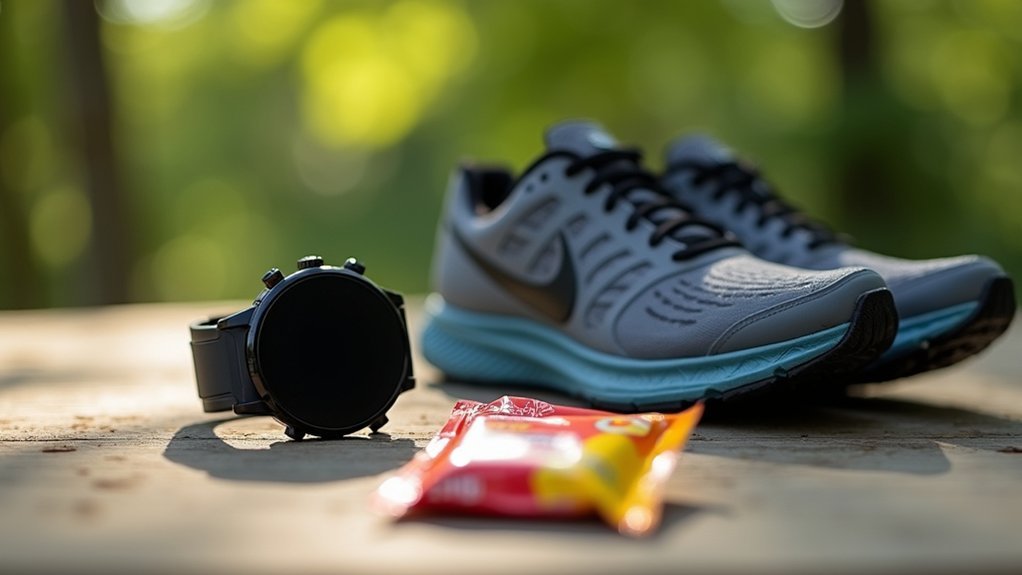
While many marathon runners focus primarily on training intensity, effective recovery between sessions proves equally essential for performance gains. Your heart rate data offers powerful insights into recovery status, helping you avoid overtraining and optimize performance.
Recovery isn’t secondary to training—it’s where your true performance gains happen. Heart rate data illuminates this critical equilibrium.
By monitoring key metrics like heart rate variability and resting heart rate, you’ll know exactly when to push harder and when to back off. Monitoring morning heart rate can provide valuable signals, as increases of over 5 beats per minute from baseline may indicate inadequate recovery.
- Track morning heart rate trends to assess readiness for training
- Use HRV measurements to gauge stress levels and recovery status
- Monitor sleep quality data to guarantee adequate deep sleep
- Adjust training intensity based on real-time heart rate feedback
- Watch for elevated resting heart rate as an early warning sign of overtraining
With consistent monitoring, you’ll maintain the perfect balance between training stress and recovery, preventing burnout while maximizing your marathon performance.
Advanced Analytics: Beyond Basic Heart Rate Tracking
Modern heart rate watches have evolved far beyond simple beat-counting devices.
Today’s advanced models offer multi-frequency support with dual frequency modes that markedly improve GPS accuracy in challenging environments like dense forests and urban canyons.
You’ll benefit from detailed metrics like Heart Rate Variability (HRV), which provides deeper insights into your cardiovascular system’s responsiveness.
Real-time split and pace analysis lets you adjust your marathon strategy mid-race, while elevation data helps you understand how terrain affects your performance.
High-end watches like the Coros Vertix 2 even include ECG sensors for more thorough heart monitoring.
These advanced analytics integrate seamlessly with training plans, allowing you to train more effectively in specific heart rate zones while tracking your VO2 max, stress levels, and recovery needs—all vital metrics for serious marathon performance.
How to Incorporate Heart Rate Training Into Your Marathon Plan
Incorporating heart rate training into your marathon preparation transforms how you approach each run and ultimately your race day performance. By structuring your training around specific heart rate zones, you’ll build endurance more efficiently while reducing injury risk.
Start by calculating your zones using the 220-minus-age formula or the MAF method, then align each workout with the appropriate intensity:
Understand your limits before challenging them—proper zone calculation creates the roadmap for every successful marathon training session.
- Base building: Spend 70-80% of your training time in Zones 1-2 to develop aerobic efficiency. For optimal results, commit to a minimum 3-month base-building phase before introducing higher intensity workouts.
- Tempo runs: Introduce Zone 3 workouts once weekly to improve lactate threshold.
- Strategic intervals: Add Zone 4-5 work sparingly (1-2 sessions weekly) for speed development.
- Recovery focus: Use Zone 1 runs after intense workouts to promote adaptation.
- Progressive overload: Gradually increase duration while maintaining appropriate zones.
Battery Life and Durability: What Marathon Runners Need
For marathon runners pushing their limits through hours of training and racing, battery life and durability rank among the most critical features in heart rate watches.
You’ll need at least 20-26 hours of GPS battery life for most marathons, with watches like the Forerunner 255 offering that sweet spot of performance.
If you’re tackling ultras or multiple training days without charging, consider solar-powered options like the Garmin Enduro 3, which delivers an impressive 320 hours in GPS mode.
Look for watches with water resistance of at least 50 meters and scratch-resistant screens that can withstand falls and rough conditions. The Garmin fēnix 8 offers exceptional durability with its titanium body and dive-rated waterproofing for extreme conditions.
Don’t overlook fast charging capabilities for those pre-race moments when you need a quick power boost.
Your watch should be as resilient as you are.
GPS Accuracy and Its Impact on Training Effectiveness
Your GPS watch’s map precision directly affects your training quality, with accurate distance and pace data allowing for optimized marathon preparation.
Be aware that higher GPS accuracy settings will drain your battery faster, potentially leaving you without tracking during longer training runs.
When running in urban environments with tall buildings, you’ll experience the “urban canyon effect” where GPS signals bounce off structures, reducing accuracy and potentially skewing your performance metrics.
Serious marathon runners should consider watches from multiple satellite systems providers like Polar, Garmin, or Suunto to ensure the most reliable tracking during critical training sessions.
Map Precision Matters
When training for a marathon, the accuracy of your GPS watch can make or break your preparation strategy. Multi-band GPS systems like those in the Apple Watch Ultra deliver superior precision even in challenging urban environments with tall buildings.
You’ll need trustworthy data to optimize your training and race day performance.
- Dual-band GPS (L1 and L5 signals) reduces interference and improves tracking accuracy
- Environmental factors like dense forests and urban canyons can compromise signal quality
- Accurate distance tracking ensures your training plans reflect actual workload
- Consistent pace data prevents overexertion and potential injuries
- Reliable route mapping helps you train on terrain similar to your target race
GPS inaccuracies can lead to underestimation of distances, pace inconsistencies, and flawed performance predictions—all potentially undermining months of preparation. Tests from the NYC Marathon showed the Apple Watch Ultra 2 recorded 26.26 miles while most other watches measured around 26.5 miles against the official 26.2-mile distance.
Battery Drain Considerations
Despite all the benefits of advanced tracking technology, marathon runners face a critical challenge when relying on GPS watches: battery life. Your watch’s battery can deplete long before crossing the finish line if you’re not careful with settings. Recent user reports indicate firmware updates can significantly worsen battery performance compared to older versions.
Heart rate monitoring and connectivity features are major power drains. Using external sensors via Bluetooth amplifies this issue considerably. Meanwhile, your GPS configuration dramatically affects longevity—single-system GPS uses less power than combined satellite systems.
| Feature | Impact on Battery | Solution |
|---|---|---|
| Heart Rate | High drain | Use sparingly for key segments |
| GPS Mode | Major consumer | Switch to GPS-only during races |
| Display | Considerable impact | Lower brightness, reduce checks |
Consider disabling unnecessary features and utilizing power-saving modes specifically designed for endurance events to guarantee your watch lasts through your marathon.
Urban Canyon Effects
Urban canyon environments pose considerable challenges for marathon runners relying on GPS watches. When you’re running between tall buildings, your watch’s GPS accuracy considerably diminishes as structures block satellite signals and create multipath interference. Similar to findings from NYC’s pilot program, these urban environments complicate traditional satellite-based positioning methods.
This impacts your training effectiveness by distorting pace calculations, distance measurements, and route tracking.
- Reduced satellite visibility leads to less precise location tracking
- Signals bouncing off buildings create misleading distance measurements
- Your pace data becomes unreliable, undermining performance analysis
- Tracked routes may show you running through buildings rather than around them
- Training adjustments based on inaccurate data can derail your marathon preparation
Consider watches that utilize multiple navigation systems like GPS, GLONASS, and Galileo simultaneously. These provide better coverage in urban environments, helping maintain accuracy during city training runs.
Comparing Data Sync and App Ecosystem Options
Modern heart rate watches have dramatically evolved beyond simple time-telling devices, offering marathon runners sophisticated data synchronization capabilities and robust app ecosystems.
You’ll find seamless integration with popular fitness platforms through Bluetooth and Wi-Fi connectivity, ensuring your training data transfers effortlessly. Some advanced models like the Polar H10 and Garmin HRM-Pro offer built-in memory for storing workout data when your phone isn’t accessible.
Consider which ecosystem best suits your needs. Polar users benefit from the Polar Beat app’s detailed analytics, while Garmin Connect offers extensive performance tracking.
Each runner’s journey demands the right data ecosystem—choose a platform that speaks your training language.
If you’re an Apple user, the Health app integration provides a holistic view of your fitness data. For social runners, Strava compatibility allows you to share achievements with your community.
Many watches now support multiple platforms simultaneously, storing workout data in built-in memory until you’re ready to sync, giving you flexibility regardless of your preferred operating system or training approach.
Budget-Friendly vs. Premium Options: Finding Your Perfect Match
When selecting your ideal heart rate watch, balancing your marathon training needs with your budget becomes a key consideration.
Budget-friendly options like basic Fitbit and Garmin models or the Polar H9 chest strap provide essential heart rate monitoring and basic fitness tracking for casual to moderate runners at around $70.
For serious marathon training, premium options like the Garmin Forerunner 265 deliver extensive features that justify their higher price point:
- Advanced metrics tracking both heart rate and blood oxygen levels
- Custom workout creation and recovery monitoring
- Multisport capabilities for cross-training
- Extended battery life that outlasts long training sessions
- High-quality AMOLED display with touchscreen navigation
Your choice ultimately depends on your training intensity and the data detail you need.
Frequently Asked Questions
How Do Heart Rate Watches Perform in Extreme Weather Conditions?
Your heart rate watch will perform well in extreme weather. They’re highly accurate with correlation rates of 0.99, though sweat, intense sunlight, and extreme cold can slightly affect optical sensor readings.
Can Heart Rate Watches Detect Potential Cardiac Issues During Training?
Heart rate watches can flag irregular patterns, but they’re not medical devices. You’ll see alerts for abnormal rates, but don’t rely on them for diagnosing cardiac issues. Always consult healthcare professionals about concerning symptoms.
How Accurate Are Wrist-Based Monitors Compared to Chest Straps?
Wrist-based heart rate monitors are less accurate than chest straps, especially during high-intensity workouts. You’ll notice they’re affected by movement, sweat, and skin tone, while chest straps provide ECG-level precision.
Are There Privacy Concerns With Storing Personal Health Data?
Yes, you should worry about privacy. Your health data can be shared with third parties, isn’t protected by HIPAA, and might be vulnerable to breaches. Always review privacy policies before sharing sensitive information.
Can Heart Rate Data Help Determine Optimal Race Day Pacing?
Yes, heart rate data can help determine your ideal race day pacing. You’ll know when you’re pushing too hard or have room to accelerate by monitoring your zones and staying within your aerobic threshold.
In Summary
You’re now equipped to choose the perfect heart rate watch for your marathon journey. Whether you invest in a premium model or select a budget-friendly option, you’ll benefit from tracking your zones, monitoring recovery, and optimizing your training efficiency. Remember, the best watch is one that fits your specific needs and becomes an essential training partner as you chase your marathon goals.

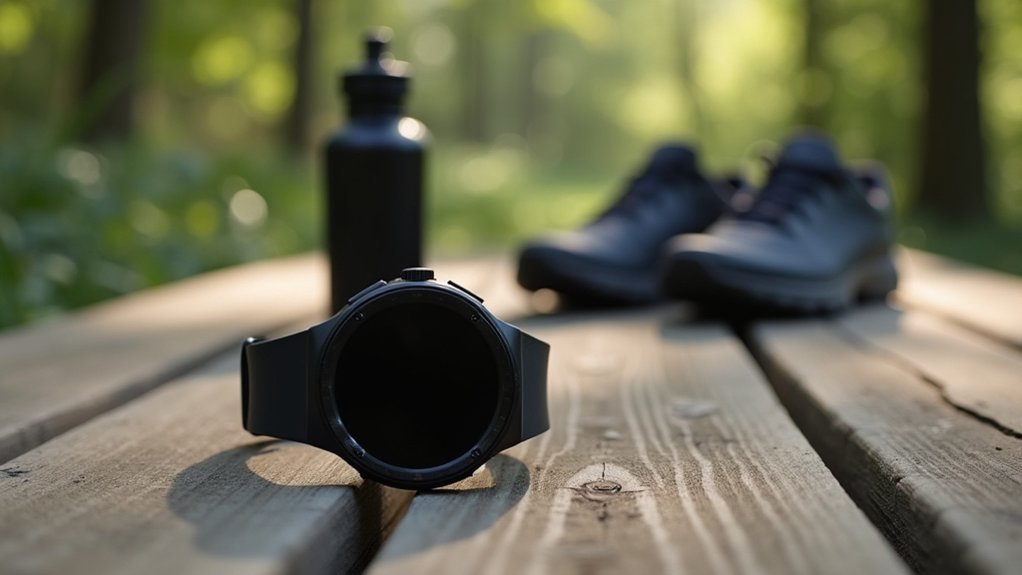
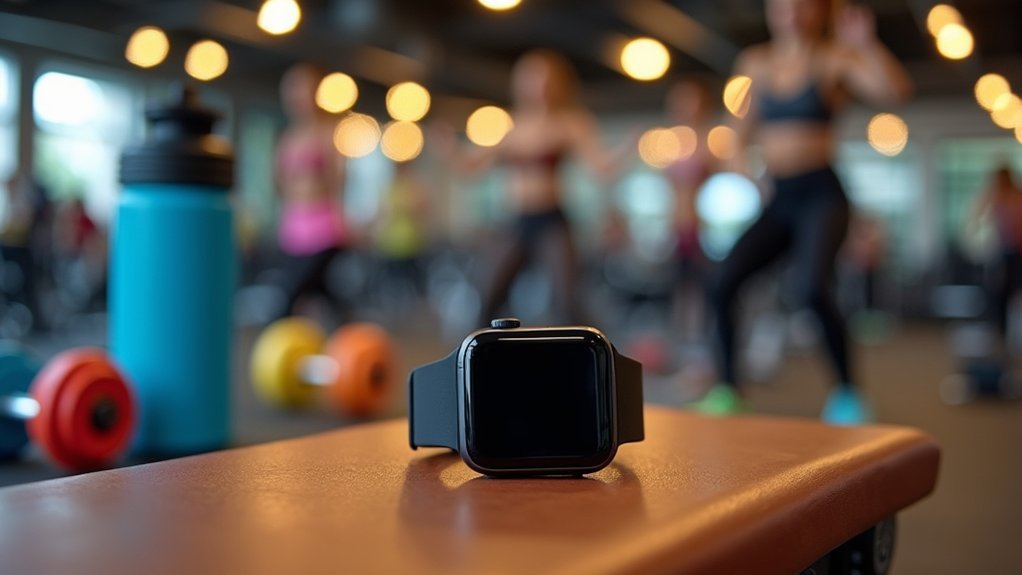
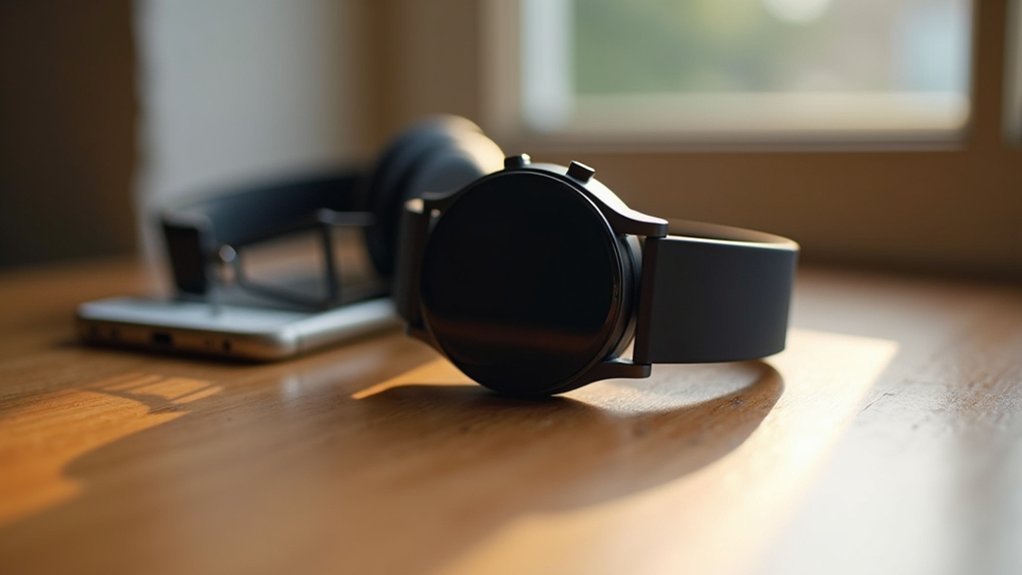
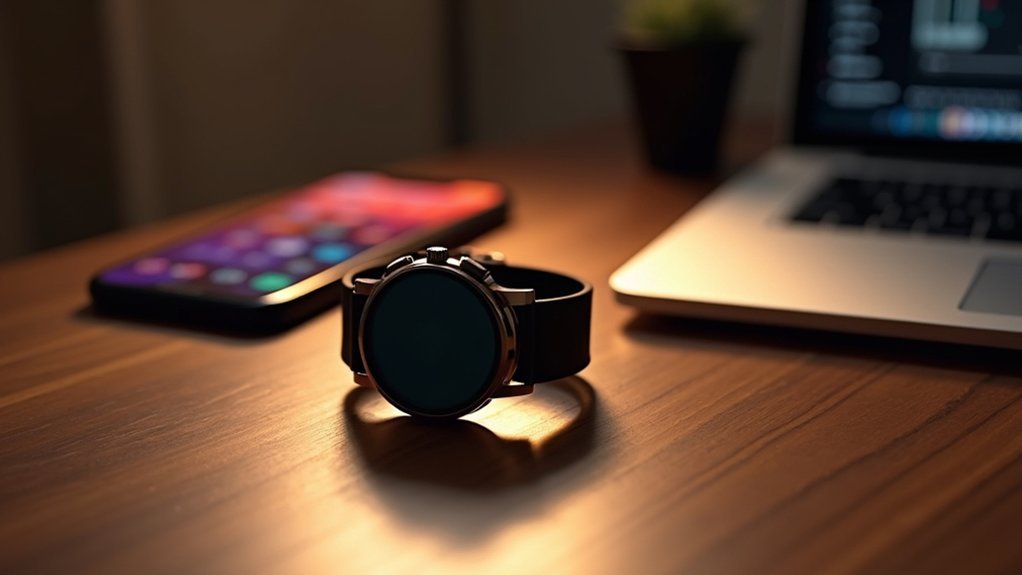
Leave a Reply